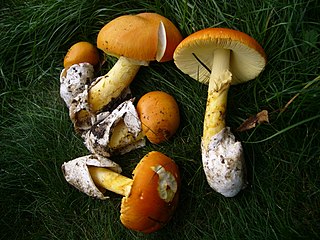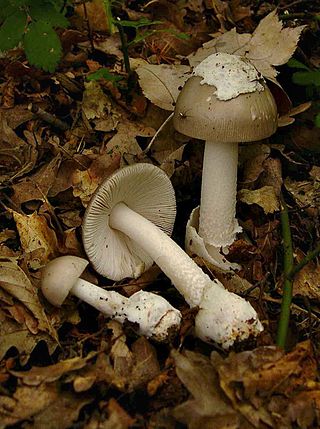
Amanita muscaria, commonly known as the fly agaric or fly amanita, is a basidiomycete of the genus Amanita. It is a large white-gilled, white-spotted, and usually red mushroom.

The genus Amanita contains about 600 species of agarics, including some of the most toxic known mushrooms found worldwide, as well as some well-regarded edible species. The genus is responsible for approximately 95% of fatalities resulting from mushroom poisoning, with the death cap accounting for about 50% on its own. The most potent toxin present in these mushrooms is α-Amanitin.

Amanita caesarea, commonly known as Caesar's mushroom, is a highly regarded edible mushroom in the genus Amanita, native to southern Europe and North Africa. While it was first described by Giovanni Antonio Scopoli in 1772, this mushroom was a known favorite of early rulers of the Roman Empire.

Amanita gemmata, commonly known as the gemmed amanita or the jonquil amanita, is an agaric mushroom of the family Amanitaceae and genus Amanita. The fruit body has a cap that is a dull to golden shade of yellow, and typically 2.5–12 centimetres in diameter. The cap surface is sticky when moist, and characterized by white warts, which are easily detached. It is initially convex, and flattens out when mature. The flesh is white and does not change colour when cut. The gills are white and closely spaced. The stem is pale yellow, and measures 4–12 cm long by 0.5–1.9 cm thick. The partial veil that covers the young fruit body turns into the ring on the stem at maturity. The spore print is white. It resembles numerous other species.

Amanita brunnescens, also known as the brown American star-footed amanita or cleft-footed amanita is a native North American mushroom of the large genus Amanita. It differs from A. phalloides by its fragile volva and tendency to bruise brown.

Amanita subjunquillea, also known as the East Asian death cap is a mushroom of the large genus Amanita, which occurs in East and Southeast Asia. Potentially deadly if ingested, it is closely related to the death cap A. phalloides.

Amanita excelsa var. spissa is a variety of basidiomycete fungus of the genus Amanita. This large, grey to brown-capped fungus has a very variable appearance but is commonly encountered in coniferous and deciduous forests in Europe and North America. It is sometimes referred to by the common name grey spotted Amanita.

Amanita chrysoblema yellow-orange variant, commonly known as the American yellow fly agaric, is a basidiomycete fungus of the genus Amanita. It is one of several varieties of muscaroid fungi, all commonly known as fly agarics or fly amanitas.

Amanita persicina, commonly known as the peach-colored fly agaric, is a basidiomycete fungus of the genus Amanita with a peach-colored center. Until c. 2015, the fungus was believed to be a variety of A. muscaria.

Amanita flavoconia, commonly known as yellow patches, yellow wart, orange amanita, yellow-dust amanita or the American yellow dust amanita, is a species of mushroom in the family Amanitaceae. It has an orangish-yellow cap with yellowish-orange patches or warts, a yellowish-orange annulus, and a white to orange stem. Common and widespread throughout eastern North America, A. flavoconia grows on the ground in broad-leaved and mixed forests, especially in mycorrhizal association with hemlock.

Amanita vaginata, commonly known as the grisette or the grisette amanita, is an edible mushroom in the fungus family Amanitaceae. The cap is gray or brownish, 5 to 10 centimetres in diameter, and has furrows around the edge that duplicate the gill pattern underneath. Unlike many other Amanita mushrooms, A. vaginata lacks a ring on the stem.

Amanita aestivalis, commonly known as the white American star-footed amanita, is a species of fungus in the mushroom family Amanitaceae. The cap of the white fruit body is 5 to 8.5 centimetres in diameter. It sits atop a stem that is 8.5 to 16 cm long. The entire fruit body will slowly stain a reddish-brown color in response to bruising. A. aestivalis may be a synonym for A. brunnescens, and may be confused with several other white-bodied amanitas. The fungus is distributed in eastern North America.

Amanita regalis, commonly known as the royal fly agaric or the king of Sweden Amanita, is a species of fungus in the family Amanitaceae. A. regalis has a scabby liver-brown cap and a stem which is yellow-ochre at the base, with patches or rings of patches. The fruit bodies somewhat resemble the smaller A. muscaria, which it was formerly regarded as a variety of.

Amanita exitialis, also known as the Guangzhou destroying angel, is a mushroom of the large genus Amanita. It is distributed in eastern Asia, and probably also in India where it has been misidentified as A. verna. Deadly poisonous, it is a member of section Phalloideae and related to the death cap A. phalloides. The fruit bodies (mushrooms) are white, small to medium-sized with caps up to 7 cm (2.8 in) in diameter, a somewhat friable ring and a firm volva. Unlike most agaric mushrooms which typically have four-spored basidia, the basidia of A. exitialis are almost entirely two-spored. Eight people were fatally poisoned in China after consuming the mushroom in 2000, and another 20 have been fatally poisoned since that incident. Molecular analysis shows that the species has a close phylogenetic relationship with three other toxic white Amanitas: A. subjunquillea var. alba, A. virosa and A. bisporigera.

Amanita ceciliae, commonly called snakeskin grisette, strangulated amanita, and the Cecilia's ringless amanita, is a basidiomycete fungus in the genus Amanita. First described in 1854 by Miles Joseph Berkeley and Christopher Edmund Broome, it was given its current name by Cornelis Bas in 1984. It is characterized by bearing a large fruit body with a brown cap 5–12 cm (2.0–4.7 in) across. The cap has charcoal-grey patches, which are easily removable. The stipe is 7–18 cm (2.8–7.1 in) long, white in colour, and there is no ring on it. It is slightly tapered to the top, and has irregular cottony bands girdling the base. The universal veil is grey. Spores are white, spherical in shape, non-amyloid, and measure 10.2–11.7 micrometres. The mushrooms are considered edible, but field guides typically advise caution in selecting them for consumption, due to risks of confusion with similar toxic species. A. ceciliae is found in woods throughout Europe and North America, where it fruits during summer and autumn.

Amanita frostiana, also known as Frost's amanita, is a small yellow-to-red fungus found in eastern North America.

Amanita muscaria var. formosa, known as the yellow orange fly agaric, is a hallucinogenic and poisonous basidiomycete fungus of the genus Amanita. This variety, which can sometimes be distinguished from most other A. muscaria by its yellow cap, is a European taxon, although several North American field guides have referred A. muscaria var. guessowii to this name. American mycologist Harry D. Thiers described a yellow-capped taxon that he called var. formosa from the United States, but it is not the same as the European variety. The Amanita Muscaria is native to temperate or boreal forest regions of the Northern Hemisphere. However, it has also been introduced in New Zealand, Australia, South America, and South Africa.

Amanita excelsa, also known as the European false blushing amanita, is a species of agaric fungus in the family Amanitaceae. It is found in Asia, Europe, and North America, where it grows in deciduous forests.

Amanita muscaria var. inzengae, commonly known as Inzenga's fly agaric, is a basidiomycete fungus of the genus Amanita. It is one of several varieties of the Amanita muscaria fungi, all commonly known as fly agarics or fly amanitas.




















